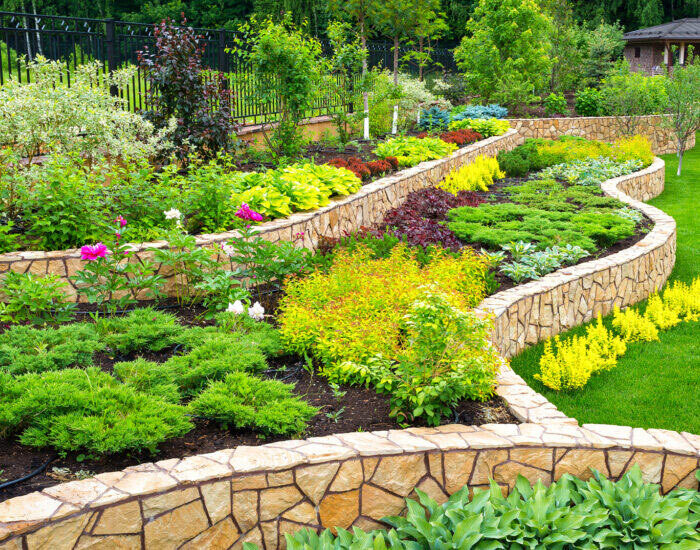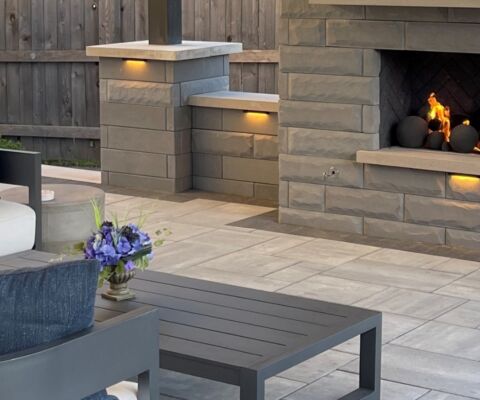July 19th, 2020
A Guide to the Perfect Flower Bed Design

Planting your own garden can be intimidating. With so many options, how are you ever supposed to create the perfect outdoor display for your home?
Don’t worry. When designing any flower bed, the key to any eye-catching arrangement is variety and repetition. Whether it be plant color, characteristics or even bloom time, intermixing a diverse collection of garden elements creates a unified yet interesting outdoor look. Follow our tips to design a flower garden that is sure to turn heads!
Choose Your Colors
First and foremost, your landscape should blend with a set color scheme. Often times choosing 2-3 complementary colors (or multiple shades of one) is a good place to start. Whether you want your garden to stand out or be more subtle, consider the colors of your flowers, foliage, bark and even pottery.
Your bed should be mostly filled with neutral-colored plants with your focal colors mixed in. Neutral colors in the garden are browns, whites, greys and greens. These colors can be intermixed with any other color to tone them down or to fill empty space. By balancing both neutral and high-intensity colors, you are able to create excitement without making your garden overwhelming.
Don’t Settle for One Characteristic
When picking the perfect garden plants, be sure to choose a variety of shapes and sizes. Whether they are small, large, flowering or grassy, a diverse collection of plants allows for an interesting landscape. The size and texture of the plants’ foliage create visually striking gardens, even after the flowers have faded.
Looks aren’t the only plant characteristics that matter. Each plant will grow best in a specific environment, so be sure to do your research. Choose plants that will thrive with the light, moisture conditions, and the topography of your yard.
Experiment with Placement
It is very important where you choose to place your plants in your garden. I good rule of thumb is to stick with odd numbers. Plant three or any odd number of the same plant either spaced apart or next to each other to create cohesiveness in your yard. Strategic repetition of flowers creates continuity from one area of the garden to another.
Be mindful when staggering your plants. It is often a good idea to put taller plants in the back of beds and shorter ones in the front. By plating in curved layers, the garden will look natural and not linear. This will also prevent plants from blocking the view of others. Additionally, spacing out similar colors and flower types will add texture and shape to your yard.
Before planting your flowers, set them out to preview what they will look like. Don’t be scared to mix things up and put different styles and colors together. In addition, elements such as rocks and furniture should be strategically placed as well.
Be Mindful of Bloom Time
Spread your plants out with bloom time in mind. Whether they are a long-living perennial, short-term annuals, or seasonal bulbs, each plant will bloom at its own time. You never want a dead area of a flower bed so be sure to do research on when each will bloom and space them out accordingly.
Focal Points Are A Must
Every garden bed needs a focal point. It’s important to add an object that commands attention and draws the eye into the planting. From a birdbath or gazing ball to a striking plant or small tree, these objects will add drama to a flower bed. A patch of the same color flower can also be successful at drawing in the viewer’s attention.
If you have multiple beds, consider making the focal point a repeating element. By placing them in different locations around your yard, you add continuity among the flower gardens.
Although the idea can seem daunting, creating your garden should be a fun task. When designing the perfect flower garden, stick to variety and repetition. Mixing a variety of plant heights, sizes, colors, scales, and textures will keep your garden engaged in all seasons. In addition, be sure to repeat similar elements to unify your entire yard. By keeping our tips in mind, your flower beds will end up balanced and beautiful for years to come.




